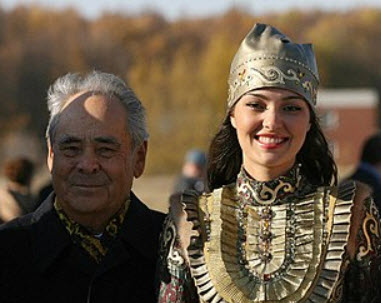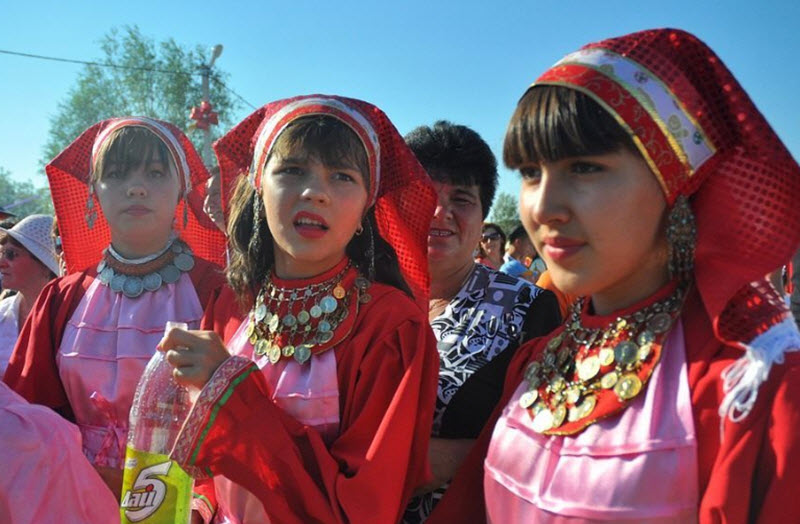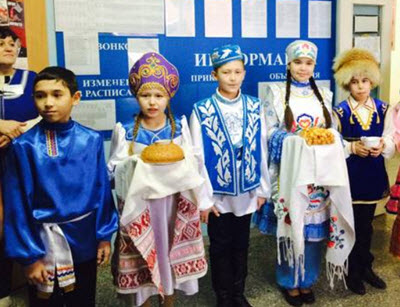Here are a a few examples of ethnic subgroups within the Volga Tatar population.
Kazan Tatars
On this page:
A majority of the Volga Tatars belong to the subgroup Kazan Tatars. Traditionally, the Kazan Tatars inhabited the left bank of the Volga River in Tatarstan. According to one (disputed) theory, the Kazan Tatars hail from the Kipchaks of the Golden Horde.
Mişär Tatars

The Mishars, also known as Mişär Tatars or Misher Tatars, are a subgroup of Volga Tatars that speak the Mishar dialect of the Tatar language. The Mishars make up approximately one third of the Volga Tatar population.
The Mishars hail from Cuman-Kipchak tribes who intermarried with the Burtas in the Middle Oka River region and Meschiora.
Most Mishars live in Tatarstan, Bashkortostan, Mordovia, Chuvashia, Chelyabinsk, Ulyanovsk, Penza, Orenburg, Ryazan, Samara, Volgograd, Saratov, Nizhny Novgorod, or Nizhegorodskaya.
There is also a Mishar speaking community of Tatars in Finland.
The Kryashens

The Kryashens, also known as Keräşens, are a subgroup of the Volga Tatars that distinguishes themselves from most other Tatars by being Orthodox Christians instead of Sunni Muslims. Because of this, they are sometimes referred to as Baptised Tatars.
There are several Kryashen dialects, but they only differ slightly from the Central dialect of the Tatar language.
The Krayshens are chiefly found in Tatarstan, Udmurtia, Bashkortostan, and Chelyabinsk. At the 2010 census, there were 34,882 recorded Krayshens in the Russian Federation. The total worldwide population is believed to be just a few hundred people more than this.
For quite a long time now, there has been a tendency for the Kryashens to assimilate into the Chuvash, another Orthodox Christian population with Turkic roots.
Background
The origin of the Krayshens is largely unknown, but the researcher Evgeny Barkar have found some evidence that indicate that the Krayshens descend from Kipchaks that converted from their Asian pagan religion to Orthodox Christiany.
According to one theory, the ancestors of the Krayshens were Suars that were converted to Christianity by Armenian Christians in the 6th century while living in the Caucasus.
Another theory suggest that they hail from Sunni Muslim Tatars that were forcibly converted to Christianity during the reign of Ivan the Terrible.
Noqrat Tatars
Noqrat Tatars are chiefly found in the Udmurt Republic and in the Kirov Oblast. Both of these places are located within the Volga District of the Russian Federation. Population data from the 1920s show that this Tatar group was small even back then, compromising just 15,000 people.
Perm Tatars
 The Perm Tatar subgroup is chiefly found in Perm Krai in the Volga District of the Russian Federation. As of 2002, the population consisted of roughly 130,000 individuals. Some researchers refer to the Perm Tatars as Ostyak Tatars, but this can lead to confusion since the term Ostyak was formerly used to refer to several indigenous peoples in Siberia.
The Perm Tatar subgroup is chiefly found in Perm Krai in the Volga District of the Russian Federation. As of 2002, the population consisted of roughly 130,000 individuals. Some researchers refer to the Perm Tatars as Ostyak Tatars, but this can lead to confusion since the term Ostyak was formerly used to refer to several indigenous peoples in Siberia.
Several different Tatar subgroups are represented in Perm Krai and Tatars can be found living in virtually all settlements here. This is also a region where there is a long-lasting tradition of close contact between Tatars and Bashkins, and in some places it is difficult to distinguish between the two groups anymore, e.g. in the Kuyedinsky District and in the Tulva River basin.
Qasím Tatars
The focal point of the Qasím Tatars is the town Qasim on the left bank of the Oka River in the Ryazan Oblast of the Russian Federation. In Russian, this town is known as Kasimov (Касимов). Today, roughly 1,100 Qasim Tatars live in Qasim. The size of the diaspora is unknown.
Qasím Khan (or Qasim of Kasimov) was the first khan of the Tatar Qasim Khanate, reigning from from 1452 to his death in 1469. Khan’s Mosque in Qasím is the oldest mosque in Central Russia. The first mosque on this spot dates back to the Quasim Khanate of the 15th and 16th centuries, but it was largely destroyed on the order of Tsar Peter the Great in 1702 – only the wide stone minaret survived. A new mosque was built next to the minaret in 1768 and this mosque is still standing. In 1835, it was given a second storey paid for by local Tatar nobles.